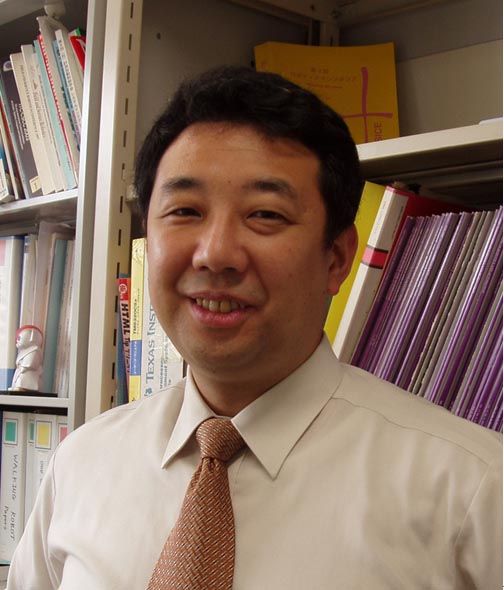|
IEEE
ICMA 2007 Conference
Plenary
Talk 3
Mobiligence:
Emergence
of Adaptive Motor Function through Interaction among the Body, Brain and
Environment
Hajime
Asama, Ph.D.
Professor
RACE (Research into Artifacts, Center for Engineering)
The University of Tokyo
Kashiwanoha 5-1-5, Kashiwa-shi, Chiba 277-8568, Japan
Tel. +81-4-7136-4255,
Fax. +81-4-7136-4242, E-mail asama@race.u-tokyo.ac.jp

Abstract:
The Mobiligence project is a
five-year project started from 2005[1], which was accepted as a program of
Scientific Research on Priority Areas of Grant-in-Aid Scientific Research from
the Japanese Ministry of Education, Culture, Sports, Science and Technology
(MEXT). In addition to the planned research groups which started in 2005, new
two-years-research groups (applied research groups) will be selected and start
from 2006.
Human
can behave adaptively even in diverse and complex environment. All the animals
or even insects can perform various types of adaptive behaviors, such as a
locomotive behavior in the form of swimming, flying walking, a manipulation
behaviors such as reaching, capturing, grasping by using hands and arms, a
social behavior to the other subjects, etc. Such adaptive behaviors are the
intelligent sensory-motor functions, and most essential and indispensable ones
for life forms to survive.
However,
the mechanisms for the generation of intelligent adaptive behaviors are not
thoroughly understood. Such an adaptive function is considered to emerge from
the interaction of the body, brain, and environment, which requires that a
subject acts or moves. Base on the consideration, we call the intelligence for
generating adaptive motor function mobiligence.
The final goal of this project is to establish the common principle underlying
the emergence of mobiligence.
In
this project, the mobiligence mechanism
is to be understood by the constructive and systematic approaches, through the
collaboration of biologists and engineering scientists who developed biological
models by integrating physiological data and kinetic modeling technologies. In
other words, the Mobiligence Project
is pursued by integrating biology and engineering, i.e., physiological analysis
(biology), modeling and experiments on artificial systems (engineering),
verification of models (biology), and discovery and application of principles
(engineering).
In
the following discussion, the focus is on three adaptive mechanisms:
1.
Mechanism whereby animals adapt to recognize environmental changes;
2.
Mechanism whereby animals adapt physically to environmental changes; and
3.
Mechanism whereby animals adapt to society.
Research
groups for each of the categories listed above are organized. The three groups
conduct their respective research and clarify the universal, common principle
underlying the mechanism of mobiligence.
In
this project, various types of adaptive motor function mechanisms performed by
humans, animals, insects, etc. are expected to be elucidates. In the medical
field, the results of our research will contribute to the discovery of a method
to improve motor impairment and develop rehabilitation systems. In addition, in
the engineering field, the results of our research will contribute to the
derivation of the design principles of artificial intelligence systems.
Furthermore, we will explore the new research field,
mobiligence, establish a research organization that integrates biology
and engineering, and implement programs to foster young engineering scientists
and biologists to conduct collaborative and interdisciplinary research between
biological and engineering research, respectively.
Hajime
Asamawas born on Jan. 18, 1959. He received MS and DS
degrees in Engineering from the University of Tokyo, in 1984 and 1989,
respectively. He worked at RIKEN (The Institute of Physical and Chemical
Research, Japan) from 1986 to 2002, and became the professor of RACE (Research
into Artifacts, Center for Engineering), the University of Tokyo in 2002. He
received JSME Robotics and Mechatronics Division Best Paper Award in 1995, JSME
Robotics and Mechatronics Division Academic Achievement Award in 2000, Best
Paper Award of Fanuc FA Robot Foundation in 2006, etc. He played
an editorship of "Distributed Autonomous Robotics Systems", its second and
fifth volume which were published from Springer-Verlag, Tokyo in 1994, 1996 and
2002 respectively. He was the IFAC TC chair on Intelligent Autonomous Vehicles
from 2002 to 2005. He is a fellow of JSME since 2004, an AdCom member of IEEE
Robotics and Automation Society since 2007, and a member of IEEE, JSME, RSJ,
SICE, etc. He is the director of the Mobiligence project in the MEXT
Grant-in-Aid for Scientific Research on Priority Areas from 2005. His main
interests are distributed autonomous robotic systems, cooperation of multiple
autonomous mobile robots, emergent robotic systems, ubiquitous systems, service
engineering, and Mobiligence, namely emergence of adaptive motor function
through the body, brain and environment.
|